Lessons & Units
A database
of lessons and units searchable by content and cultural standards,
cultural region and grade level. More units will be available soon.
You can use Acrobat Reader to look at the PDF version of the Cover
Sheet
for the Units and Self-Assessment
for Cultural Standards in Practice.
Winds
And
Weather
by Jonas Ramoth and Sidney Stephens
Activity Series 1: Convection
–If you open the door of a warm house on a cold day,
there's the wind.”
-Jonas Ramoth
| Background |
Convection currents stirring the atmosphere produce winds. Convection
is a cyclic process in which heat energy is transferred in fluids (liquids
or gases). If a fluid is heated (a), it expands, becomes less dense and
rises (b). When this warm liquid reaches the surface, it spreads out and
begins to cool (c). As the fluid gets farther from the heat source, it cools
down, and the cooler fluid sinks (d). Thus a convection current or cell
is completed when the cooler, sinking fluid flows inward (e) towards the
heat source to replace the upward-moving, hotter fluid (a). This cycle is
what drives both local and global winds as well as volcanic eruptions, the
swirling patterns in miso soup, ocean currents, home heat circulation patterns
and mountain building.*
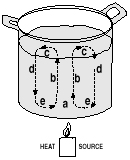
|
|
Activity 1a
Materials
|
Pencils, tape, tissue paper, scissors, string, hole punch
|
|
Procedure
Gear-up
|
- Read the opening quote from Jonas Ramoth: If
you open the door of a warm house on a cold day, there's the wind. Ask them what they think
Jonas means by this. Ask them to imagine this situation and to diagram
and describe in their journals the movement of air when the door is
opened. Students will have had lots of experience with this phenomena
and will probably say things like –hot air rises” and –cold rushes in”,
but use questions like the following to probe their understand-ing
of
air movement particularly with regard to the convection cycle.
- Provide students with a copy of the Learning Cycle Model Scoring
Guide** and let them know that their learning will
be assessed using this checklist. Students will use the form as a self-evaluation
and you will use it as a checklist as students work through the explorations
and as you review their journal entries.
|
| Explore/Generalize |
- Have students construct wind detectors by using
string to attach a 1 x 3 inch strip of tissue paper to a pencil as
shown. (You'll want
to test design ahead of time to make sure it is weighted sufficiently
to swing with wind.)

- Ask them to go to an outside door on a cold winter day***,
open the door just a few inches (from inside) and hold the detector
near the floor. Observe and record which way the tissue/wind moves.
- Now hold the detector in the middle of the door and then near the
top. Observe and record movement of wind detector.
- Ask which way the air is moving at each of these locations. Does
the air movement seem to be as strong at each level? What are your ideas
about this? How do these observations compare with your original ideas?
- How do you think air would move if you opened the door of a hot oven
in a warm room? Test and find out.
- Discuss how these observations compare with their original ideas.
Have them revise journal diagrams if they want.
|
LEARNING CYCLE MODEL SCORING GUIDE
|
----Exploration----
|
|
1
|
2
|
3
|
- Initiates activities with no forethought or avoids activity completely
- ignores needs and contributions of peers
|
- interacts with phenomena as instructed
- works politely with peers, but sticks to personal agenda
|
- asks clarifying questions
- uses a variety of methods to interact with the subject
- works cooperatively with peers and gains insights from their activities
|
- no organized attention or skills applied to task at hand
|
- measurements, observations, and classifications are recorded, but
with little attention to detail
|
- makes careful observations, measurements, and classifications
- records measurements, observations, and inferences
|
- shows minimal intellectual interaction with materials being manipulated
|
- fluid interactions with phenomena, but they sometimes are off target
with intended activities
|
- identifies and seeks to expand personal understanding of the concept
or phenomena
|
|
----Generalize----
|
|
1
|
2
|
3
|
- shows little participation in discussions
- demonstrates non-supportive behavior for others' input
|
- engaged in discussion as a participant
- does not initiate many questions
|
- asks thoughtful questions
- shows respect for other ideas
|
- does not distinguish between observations and inferences
- looks upon guesses as fact
|
- has basic understanding of the differences between observation and
inference.
- understands that a hypothesis is a kind of scientific guess
|
- distinguishes between observations and inferences
- identifies relevant observations and interpretations
- looks upon guesses as hypotheses to be tested
|
- jumps to conclusions that are not based upon recent manipulations
of the phenomena
|
- considers data before making conclusions
|
- avoids jumping to conclusions
- identifies alternative explanations for phenomena
|
|
----Apply----
|
|
1
|
2
|
3
|
- does not recognize applicability of knowledge gained from both successes
and failures of experimental process
|
- creative application ideas, but they do not address personal or societal
needs
|
- offers to apply new knowl-edge to positive benefit of society
|
- does not refer to principles and concepts discovered in earlier generalizations
|
- applications loosely associated with principles of concept
|
- refers to principles which were discovered in the generalize stage
in spite of new context
|
- does not offer applications of new knowledge regardless of context
|
- applications offered, but does not transcend original context
|
- transfers application of concept to new context
|
|
Activity 1b
Materials
|
Per group: large, wide-mouthed jar, water, baby food jar, aluminum foil,
food coloring, rubber bands, string, sharp pencil
|
| Explore/Generalize |
- Have students fill a large (gallon), wide-mouthed jar two-thirds
full with cold water. Next, put three drops of food coloring in a baby-food
jar. Fill the baby-food jar to the top with hot water. Cover it with
aluminum foil and secure the foil tightly with rubber bands. Tie a string
around the baby-food jar and lower it into the bottom of the large jar.
Predict what you think will happen when you punch a hole in the foil
and record prediction in journal.
- Wait until the water is still and then punch
one hole in the foil with a long pencil. Watch and record what happens.
(Nothing happens
because the cold water is heavier than the warm water and pressing
down upon the hot water, but there is no –escape hole” allowing the
warm water to be pushed out by cold.)
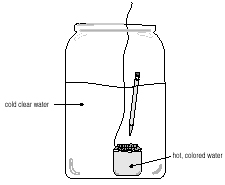
- Ask students why nothing happens with just one hole. Ask for solutions
and then have them punch a second hole, observe and record.
- Ask what they observed when the second hole was punched? Did the
colored fluid rise from only one, or both of the holes? What are your
ideas about this? How long will it keep rising? After a long time, what
will the fluid in the large jar be like? What are your ideas about why
this is so? (The colored hot water will rise from one hole in a fairly
straight line. As it rises, it will cool and begin to both sink and
diffuse into the cold water as water temperatures equilibrate. Depending
upon water tempera-tures, a complete convection cell may or may not
be visible with the red/hot water.)
- Ask students to compare this activity to the door activities. What
do they now think the air movement in a warm room on a cold day might
look like?
|
|
Activity 1c****
Getting Ready
|
The last two activities demonstrated what happens when fluids of unequal
temperature meet. This activity demonstrates how warm and cold surfaces
affect air. To do this, an observation box and smoke-filled air piston
must be created as follows:
|
| Materials |
Observation Box: 1 per Student Team
1 cardboard box (about 30 cm x 30 cm x 50cm) per team
clear plastic food wrap
plastic tape
straws
Smoke Piston
1 large air piston
1 plastic straw
heavy cotton string, 12 cm long
matches
scissors
baby food jar of tap water
|
| Procedure |
- Remove one side of the box; then cut a window in two sides as shown.
but leave about 1/3 of the top intact. Tape plastic food wrap over the
windows so that they are airtight. In one end of the box, cut a small
hole just large enough to insert a plastic straw.
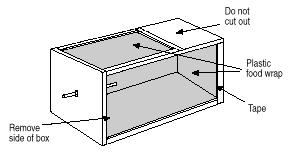
- Cut the straw into 4-5cm lengths. Cut the string into lengths of
about 4cm. Double one of the pieces of string twice or more until it
will fit snugly in the end of a piece of the plastic straw. Leave about
1/2 cm of the doubled string sticking out of the straw. Repeat the procedure
for the other pieces.

- Slip a section of the prepared straw onto the
air piston. Light the string, being careful not to melt the straw.
Collect smoke in the cylinder
by slowly drawing out the plunger. Remove the straw and lay it aside
where it won't burn anything. You may need more smoke later. Insert
figure six with step 3 narrative.
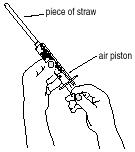 |
| Explore |
- Working in student teams, place a pan of cold water, ice water, ice
cubes or snow inside the observation box. Be sure the straw is in place
through the end of the box. The end of the straw should not be over
the pan of water.
- Insert a smoke-filled air piston into the straw of the observation
box. Gently force smoke through the straw into the box so that it moves
very slowly over the cold water. Observe and record what happens to
the smoke.
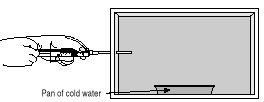
- Repeat using a pan of hot water. Observe and record what happens.
|
| Generalize: |
- Ask student to report what they observed with the smoke and cold
water. (See diagrams below.) Ask them to use arrows to diagram the movement
of air in the box. What are their ideas about this? How about for hot
water?
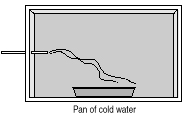 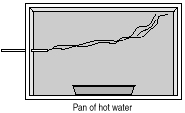
- Ask how these observations and ideas compare with their earlier ideas
about the open door.
|
| Apply |
- Ask students what their ideas now are about air movement when a door
is opened on a cold day? Ask them to review their original journal predictions
and revise the diagram/explanation using evidence from explorations
as support for their ideas.
- Take students outside on a calm day when smoke is visible from smoke
stacks. Ask them to diagram and explain smoke movement and air temperatures
at different levels using evidence from these explorations in support
of their ideas. (See sample diagram)
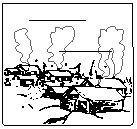 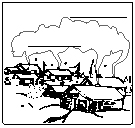
- Ask students to imagine a hot summer day in Selawik where the air
temperature is much warmer than the water temperature of Selawik Lake.
Ask them to diagram air movement and explain it using evidence from
these explorations.
- Ask what might wind patterns be like in the late fall just before
freeze-up of Selawik Lake when the water temperatures are warmer than
air temperatures, particularly at night? Do your predictions match your
experience? Check with the TF to see if your predictions match his or
her experience.
|
| Assessment |
Embedded assessment using LCM Scoring Guide Student self-assessment using
LCM Scoring Guide Review and response to student journal entries |
* Gould, A., (1988) p.30
** Note: originally called "Learning Cycle Model: Analytical
Trait Assessment" in Murphy, N. 1992 pp 27-28
*** Opening a freezer door also works
**** Adapted from Intermediate Science Curriculum Study (1972)
p. 2-4
Standards
Section I - Observing Locally
Section II - Understanding Wind
Section III - Connecting
Globally
Appendix A - Selawik Weather Information from
Jonas Ramoth
Appendix B - Assessment
Appendix C - Weather Resource
List
Appendix D - Interdisciplinary Integration
Handbook
for Culturally Responsive Science Curriculum by Sidney Stephens
Excerpt: "The information and insights contained in this document will be
of interest to anyone involved in bringing local knowledge to bear in school
curriculum. Drawing upon the efforts of many people over a period of several
years, Sidney Stephens has managed to distill and synthesize the critical ingredients
for making the teaching of science relevant and meaningful in culturally adaptable
ways." |